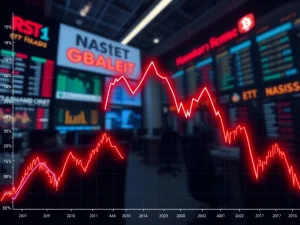Urgent: Warren Buffett’s Cash Hoard Signals Potential Market Downturn for Bitcoin and Stocks

A critical question now occupies the minds of investors: Is **Warren Buffett’s** growing cash pile a harbinger of significant market shifts for both traditional equities and the dynamic world of cryptocurrencies, particularly the **Bitcoin price**? This renowned investor, often called the ‘Oracle of Omaha,’ has historically demonstrated a keen ability to navigate market cycles. His company, Berkshire Hathaway, appears to embrace fear when others show greed, a pattern that often precedes major market corrections or even a **stock market crash**.
Warren Buffett’s Strategy: Fear When Others Are Greedy
Berkshire Hathaway, under the astute leadership of **Warren Buffett**, recently escalated its cash holdings to an unprecedented level. By mid-2025, the company’s combined Treasury bills and cash reached approximately $350 billion. This figure marks an all-time high for Berkshire and represents the largest cash reserve among all US public firms. Such a substantial cash position naturally prompts questions about its implications for the broader financial landscape, including the volatile **Bitcoin price** movement.
Many observers consider Buffett’s increased liquidity a significant indicator. He has consistently raised cash during periods of perceived market excess. In essence, he acts fearfully when the market exhibits widespread greed. This counter-cyclical approach has served him well over decades. His actions often provide a valuable signal, especially for those tracking potential market reversals.
For instance, in 1998, Buffett directed Berkshire to reduce its stock exposure. Concurrently, he significantly increased cash holdings to $13.1 billion, accounting for about 23% of total assets. By mid-2000, this cash position peaked near $15 billion, roughly 25% of assets. Subsequently, Buffett strategically deployed this capital to acquire undervalued assets after the Dot-Com bubble dramatically burst. This move allowed Berkshire to capitalize on market dislocations, securing bargains while others faced severe losses.
Buffett repeated this pattern ahead of the 2008 financial crisis. By the first quarter of 2005, Berkshire’s cash and equivalents surged to $46.1 billion. This amount equaled 51% of shareholder equity, marking the highest level during that era and closely mirroring current percentages. Cash reserves remained elevated into 2007, reaching $44.3 billion, or about 29% of total assets, just before the global financial crisis unfolded. These historical precedents highlight a clear strategy: accumulate cash when valuations are high, then deploy it when market fear creates opportunities.
The Overheated Nasdaq and Bitcoin’s Vulnerability to a Stock Market Crash
Buffett’s current caution appears particularly relevant given today’s elevated equity valuations. The **Nasdaq** market capitalization has surged to an astonishing 176% of the US M2 money supply. This figure stands significantly above its 131% peak during the Dot-Com era, according to data from Maverick Equity Research, as highlighted by The Kobeissi Letter. Furthermore, when measured against the US GDP, the **Nasdaq** now registers at 129%. This nearly doubles its 2000 high of 70%. These record valuations suggest that stock prices have outpaced both the money supply and overall economic growth by a considerable margin. Such disconnects often signal unsustainable market conditions.
For cryptocurrency investors, these equity market signals carry substantial weight. **Bitcoin** has demonstrated a strong correlation with the **Nasdaq**, particularly over the past year. Its 52-week correlation coefficient stands at 0.73. This means that, more often than not, the leading cryptocurrency moves in tandem with tech stocks. This strong positive correlation indicates that a significant downturn in the tech-heavy Nasdaq would likely exert downward pressure on the **Bitcoin price**. As institutional money flows into both tech stocks and digital assets, their price movements become increasingly intertwined.
The implications are clear: If Buffett’s record cash position accurately predicts risks in traditional equities, then **Bitcoin** could also face considerable downside. Investors must therefore monitor not only crypto-specific catalysts but also broader macroeconomic indicators and equity market trends. The close relationship between Bitcoin and the Nasdaq means that a potential **stock market crash** could cascade into the digital asset space, affecting even the most prominent cryptocurrencies.
The Role of M2 Money Supply: A Counter-Narrative for Bitcoin Price
While **Warren Buffett’s** cash hoard and the **Nasdaq’s** elevated valuations present a cautious outlook, another crucial factor could influence the **Bitcoin price** trajectory: the rate of **M2 money supply** growth. The US M2, which tracks liquid cash and deposits, has recently resumed expansion after a period of stagnation throughout much of 2025. By July 2025, it had increased by 4.8% year-over-year, reaching $22.1 trillion. This represents the fastest growth pace since early 2022, according to FRED data.
Earlier in the year, M2 growth hovered closer to 2.4%, indicating a noticeable acceleration in momentum. This shift is not isolated to the US. Globally, more than 20 central banks have already implemented rate cuts in 2025. Forecasts suggest the Federal Reserve might follow suit with its own easing policies. Such actions could potentially push annual M2 growth back towards 10–12%, according to economist Daniel Lacalle. An expanding money supply often floods the market with liquidity, making assets more attractive and potentially inflating their values.
Historically, **Bitcoin** has significantly benefited from periods where policymakers expand the money supply to support equity markets. This phenomenon was evident post-2020. During that time, BTC surged dramatically from approximately $3,800 to a record $69,000 as global M2 ballooned. Analyst CryptoRodo emphasizes this relationship, stating, “Global M2 (money supply) has historically led Bitcoin by ~12 weeks.” He further notes, “Every time liquidity re-accelerates, BTC eventually follows.” This suggests that despite the immediate risks signaled by Buffett and the **Nasdaq**, a sustained increase in **M2 money supply** could provide a powerful tailwind for the **Bitcoin price**, potentially pushing it to new highs.
Navigating Market Uncertainty: Buffett’s Caution vs. Liquidity Injections
Investors now face a complex landscape, balancing the cautionary signals from **Warren Buffett’s** record cash holdings against the potential for renewed liquidity injections via **M2 money supply** expansion. On one hand, Buffett’s historical track record in predicting market downturns, coupled with the **Nasdaq’s** current stretched valuations, suggests a looming risk for both traditional stocks and, by extension, **Bitcoin**. His strategy of being fearful when others are greedy has proven remarkably effective in preserving capital and seizing opportunities during a **stock market crash**.
Conversely, the re-acceleration of global M2 money supply presents a compelling counter-argument. Central bank policies aimed at easing monetary conditions often lead to a ‘liquidity pump’ that historically benefits risk assets, including cryptocurrencies. This dynamic could potentially mitigate the negative impacts of a market correction, or even propel the **Bitcoin price** higher, despite the underlying economic vulnerabilities. The interplay between these powerful forces will largely determine market direction in the coming months.
For investors, prudent decision-making requires a holistic view. Monitoring central bank actions, global liquidity trends, and key valuation metrics remains paramount. While the correlation between **Bitcoin** and the **Nasdaq** suggests vulnerability, the broader economic context, particularly concerning the **M2 money supply**, offers a nuanced perspective. Ultimately, market participants must weigh these opposing forces to position themselves effectively in an evolving financial environment. The current scenario underscores the importance of diversified portfolios and a clear understanding of both traditional and digital asset market drivers.









